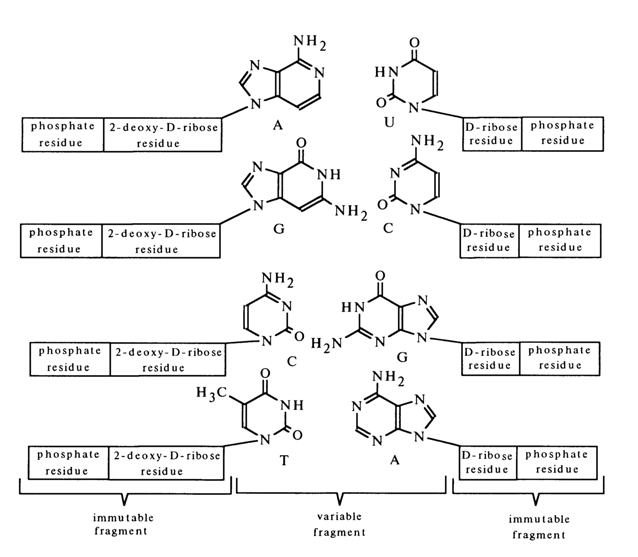![]() Go to frame view (Recommended only for
screen resolution 1024x768)
Go to frame view (Recommended only for
screen resolution 1024x768)
3.4 General Comments Regarding the Structure of Monomer Units in Nucleic Acids
Structurally, all constituent nucleotides in nucleic acids share a number of common features.
(1) The phosphoric acid residue both in the ribonucleotide (monomer unit of RNA) and in deoxyribonucleotide (monomer unit of DNA) is always linked to pentose:

Thus, pentose phosphate is the common constituent of monomer units in both RNA and DNA. It does not seem to impart any unique properties to the monomer unit of the corresponding nucleic acid; quite on the contrary, its role boils down to giving the unit a universal trait inherent in every monomer.
(2) The only component of ribo- and deoxyribonucleotides that may vary is the heterocyclic base. A characteristic structural feature of this component stems from the fact that it belongs to two similar yet markedly distinct classes of heterocyclic compounds - pyrimidine and purine bases. Both belong to aromatic heterocycles containing several nitrogen atoms in the ring, as well as exocyclic oxo and/or amino groups. These heterocyclic bases, however, differ in size, electron density distribution in the molecule, and also in the nature of the nitrogen involved in the linkage with the universal component of the monomer. As can be seen from Figure 3-1, heterocyclic bases and, consequently, monomer units in RNA and DNA form a rather limited set. In both cases, it consists of two pyrimidine and two purine bases. The difference between the constituent bases in both nucleic acids is minor and resides only in that RNA contains uracil instead of 5-methyluracil (thymine) which is present in DNA.
Hence, the distinctive features of the monomer unit in a particular nucleic acid must be determined by the heterocyclic base, and the role (function) to be performed by the monomer unit in question must be a manifestation of the special qualities inherent in the base - that is, its structure and properties.

Fig. 3-1. Structural units of DNA and RNA
(3) All monomer units of nucleic acids have some common structural features: their permanent (carbohydrate phosphate) and variable (heterocyclic base) components are linked via an N-b-glycosidic bond, whereas pentose (ribose or deoxyribopentose) always belongs to the D-series and have a b-configuration.
It is interesting to compare the typical common features of these monomer units and those of proteins which are, just as nucleic acids, highly important biopolymers.
The monomer units of a protein are represented by organic compounds of a single type, namely, amino acids. Their structural component that varies is the side chain radical R which determines whether the amino acid is hydrophobic or hydrophilic.

The monomer unit of nucleic acids is made up of three components with widely differing structure and properties. Two of them are organic compounds belonging to entirely diverse categories (carbohydrates and heterocyclic bases), while the third one is essentially a residue of phosphoric acid exhibiting, unlike many inorganic acids, a number of unique properties (it is tribasic, virtually lacks oxidative and reductive capacity, and its esters display, as will be shown in what follows, dual reactivity). Whereas the invariable and variable components of the protein's monomer unit, amino acids to be precise, form a framework of considerable strength, the nucleic acid's monomer unit, or nucleotide, is held together by weak linkages, namely, glycosidic and phosphoester bonds, which may be selectively ruptured (in enzymatic or chemical hydrolysis, etc.). The monomer unit of protein lacks such "hot spots".
The most striking difference is in the number of monomer units: a
protein typically contains at least twenty different units (20 different
"ordinary" amino acids may be encountered), while each nucleic acid (DNA or RNA)
has only four ![]() .
.